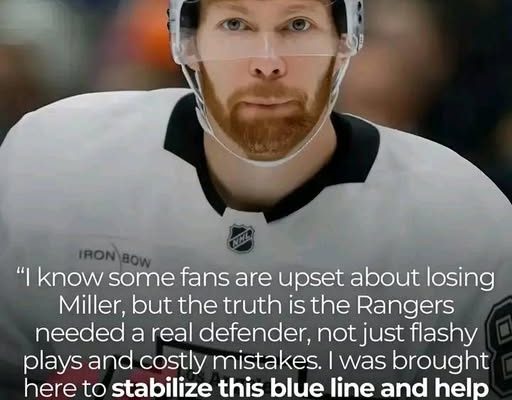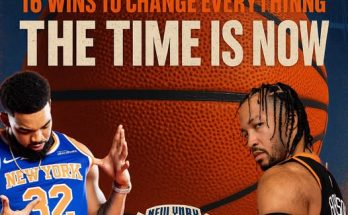The New York Rangers are at a pivotal point in their franchise trajectory, balancing their aspirations of chasing a Stanley Cup with the need to properly allocate resources to ensure long-term stability. One of the most debated aspects of their roster construction has revolved around the defense corps, specifically the evaluation of K’Andre Miller versus Vladislav Gavrikov. On paper, it may seem counterintuitive to argue that the Rangers are better off with Gavrikov rather than Miller, especially given Miller’s youth and pedigree. However, a deeper dive into playing style, reliability, contract structure, and the broader team context makes the case that Gavrikov is in fact a better fit for this Rangers roster and its ultimate goal of winning in the playoffs.
K’Andre Miller has been one of the more intriguing players for the Rangers since his arrival. Drafted in the first round, he immediately brought to the table an exciting blend of size, skating, and offensive upside. Standing at 6-foot-5, he looks every bit like the kind of modern defenseman franchises covet: rangy, mobile, and capable of leading the rush or defending with reach. His early flashes of brilliance gave fans reason to believe he could develop into a true top-pairing defenseman alongside Adam Fox. But with that tantalizing potential came inconsistency, particularly in his defensive game. Miller’s offensive instincts sometimes leave him out of position. His reliance on athletic recovery rather than strong defensive fundamentals has exposed weaknesses against elite playoff competition. As much as his highlight-reel rushes can electrify Madison Square Garden, they often mask lapses that carry serious costs in high-stakes environments.
Contrast that with Vladislav Gavrikov, a player whose game is not nearly as flashy, but who provides exactly what the Rangers need. Gavrikov is a stay-at-home defenseman by trade, someone who thrives in suppressing scoring chances and simplifying his approach. He does not attempt to carry the puck end to end, nor does he make risky pinches in the offensive zone. Instead, he leans on sound positioning, physical play, and a steady presence in the defensive end. For a Rangers team that already boasts high-end puck movers like Fox and Jacob Trouba, Gavrikov’s skill set balances the blue line. His ability to anchor a pairing allows his partner the freedom to be aggressive offensively, knowing that Gavrikov is reliably covering the defensive responsibilities.
The key point here is that winning teams need balance, not just talent. Miller’s ceiling might still be higher than Gavrikov’s in the abstract, but the Rangers are not building for an abstract future—they are building to win now. The window with Artemi Panarin, Mika Zibanejad, Chris Kreider, and Igor Shesterkin in their prime years is not indefinite. Every roster decision must be viewed through the lens of maximizing immediate competitiveness. Gavrikov, with his battle-tested defensive game and playoff experience, aligns perfectly with that mission. Miller, though promising, has not yet proven to be the shutdown force the Rangers require in the crucible of postseason hockey.
The financial aspect of the decision cannot be ignored. Miller’s restricted free agency and projected next contract represent a significant cap commitment. Young defensemen with his size and skating ability command hefty paydays, even when their games are incomplete. Committing long-term dollars to a player still learning how to consistently defend carries inherent risk. Gavrikov, on the other hand, has a more defined market value. His role is clear, and his contract expectations are more manageable relative to what he brings. For a team like the Rangers, operating with tight cap constraints and needing to ensure every dollar is maximized, this difference in cost-to-value ratio tilts the scales toward Gavrikov.
Another factor is fit within the coaching philosophy. Peter Laviolette has emphasized a structured defensive system that relies heavily on defensemen maintaining strong gaps, clearing the crease, and preventing extended zone time against. This is where Gavrikov shines. His discipline within system play is one of his greatest assets. He does not deviate from assignments in pursuit of offense, which means the team benefits from greater predictability in its defensive structure. Miller, conversely, has been prone to freelancing. While his raw tools allow him to recover more often than not, the margin for error shrinks dramatically in playoff hockey. Teams like the Tampa Bay Lightning and Carolina Hurricanes thrive on exploiting even small lapses, and Miller’s tendency to gamble plays directly into their strengths. Gavrikov’s more conservative, team-first style aligns more seamlessly with Laviolette’s system, making him the more dependable option.
The psychological and locker room dynamic should also be considered. Veterans often prefer playing with partners who simplify the game and provide consistency. A forward group plays with greater confidence knowing that the defensemen behind them are not prone to risky decisions that might lead to odd-man rushes the other way. Gavrikov has earned a reputation as a steadying influence, the type of partner who makes life easier for whoever he plays alongside. This cannot be overstated when it comes to building trust across a lineup. In contrast, Miller’s learning curve and occasional defensive miscues can create frustration, particularly in a room where the expectation is not just to compete but to contend for a championship.
Playoff performance remains the ultimate barometer, and this is perhaps the strongest argument in Gavrikov’s favor. In the postseason, time and space disappear, and the game becomes a grind. Offensive-minded defensemen who thrive in open ice often struggle when lanes are clogged, forechecks are relentless, and mistakes are magnified. Gavrikov has shown in his career that he can withstand this environment, leaning on fundamentals and physicality to shut down top opposition. Miller has yet to demonstrate that his style translates as effectively. His speed and offense can be neutralized by disciplined playoff opponents, leaving his defensive weaknesses exposed. For a Rangers team that has experienced the heartbreak of coming close but not breaking through, the need for reliability on the back end is paramount.
One might argue that letting go of Miller or prioritizing Gavrikov limits the Rangers’ upside. That perspective underestimates the unique composition of this roster. The Rangers already possess elite skill in Adam Fox, whose offensive production from the back end is among the league’s best. They do not need another defenseman to play a similar style, particularly one who has not mastered his defensive responsibilities. What they need is complementary depth, players who can fill the gaps and round out the team. Gavrikov is not a star, but he does not need to be. He needs to be effective in his role, and by doing so, he allows the stars to shine more freely.
Additionally, Gavrikov’s physicality addresses a persistent criticism of the Rangers in recent years—that they were too soft in their own zone. Teams like the Islanders and Devils have at times bullied the Rangers in playoff-style hockey, winning battles along the boards and in front of the net. Gavrikov provides an edge that Miller, despite his size, has not consistently delivered. Miller’s game leans more toward finesse, using reach and skating rather than brute strength. While that can be effective, it has not always deterred opponents from establishing presence in the Rangers’ crease. Gavrikov, by contrast, embraces the physical grind, clearing bodies and protecting his goaltender with vigor. This toughness is invaluable in the playoffs, where every goal is hard-earned and protecting the crease is non-negotiable.
There is also the developmental plateau to consider. While Miller is still young and capable of improving, the question is whether he will actually make the leap from tantalizing potential to consistent reality. Defensemen can take longer to develop, but the Rangers do not have unlimited time to wait. With their current core, the next three to five years are the window in which they must push for a Cup. Relying on the hope that Miller irons out his defensive issues by then is a gamble, one that could cost them dearly if it does not pan out. Gavrikov represents the safer, surer option—perhaps with a lower ceiling, but certainly with a higher floor.
In the end, the decision between Vladislav Gavrikov and K’Andre Miller comes down to priorities. If the Rangers were a rebuilding team looking toward the distant future, Miller’s potential would make him the obvious choice. But the Rangers are not rebuilding—they are chasing championships. In that context, the dependable, playoff-tested, defensively sound Gavrikov provides more immediate and practical value. He offers balance to a roster already loaded with offensive skill, stability in a defensive structure that demands discipline, and physicality that addresses a long-standing weakness.
The allure of Miller’s upside will always generate debate, and rightfully so. But championships are not won on potential—they are won on execution, reliability, and the ability to rise to the challenge when the stakes are highest. Vladislav Gavrikov embodies those traits in ways that K’Andre Miller has not yet proven. For a Rangers team determined to maximize its current window, the choice becomes clear: they are better off with Gavrikov anchoring the blue line than waiting on Miller to become the player they hope he might one day be.
This is not an indictment of Miller as a failed player, but rather a reflection of fit, timing, and context. The Rangers need what Gavrikov provides right now. They cannot afford the luxury of patience, not with Panarin, Kreider, and Zibanejad all on the wrong side of 30, and Shesterkin in his prime years. Every season counts. And every defensive decision could mean the difference between another near miss and finally lifting the Stanley Cup. Gavrikov may not bring the same highlight-reel potential as Miller, but he brings something more valuable for the Rangers’ present reality: certainty, balance, and trust when the games matter most.



